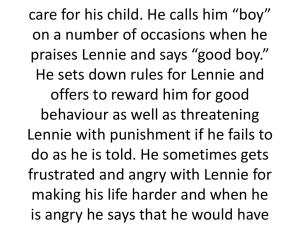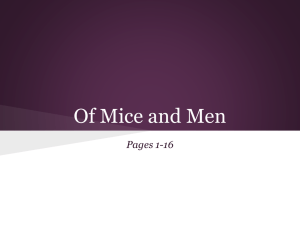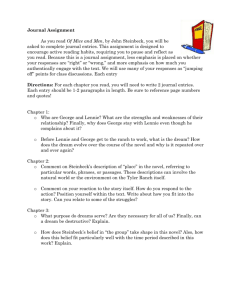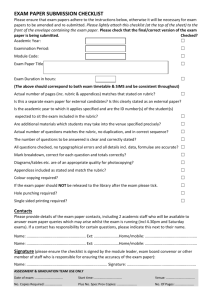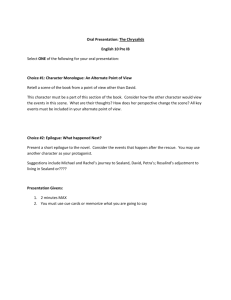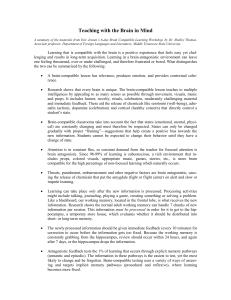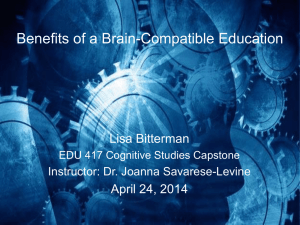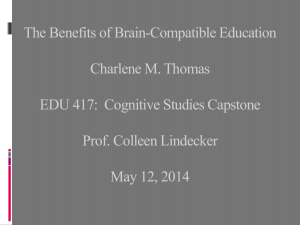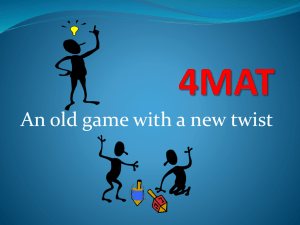Topic: Of Mice and Men
advertisement
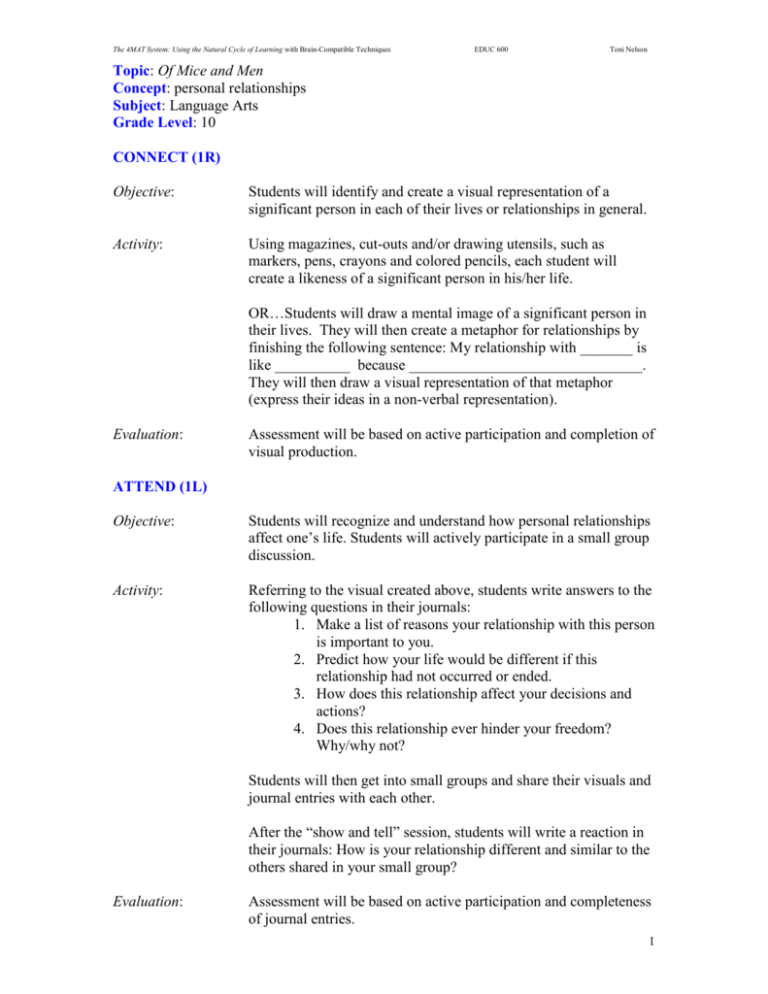
The 4MAT System: Using the Natural Cycle of Learning with Brain-Compatible Techniques EDUC 600 Toni Nelson Topic: Of Mice and Men Concept: personal relationships Subject: Language Arts Grade Level: 10 CONNECT (1R) Objective: Students will identify and create a visual representation of a significant person in each of their lives or relationships in general. Activity: Using magazines, cut-outs and/or drawing utensils, such as markers, pens, crayons and colored pencils, each student will create a likeness of a significant person in his/her life. OR…Students will draw a mental image of a significant person in their lives. They will then create a metaphor for relationships by finishing the following sentence: My relationship with _______ is like __________ because _______________________________. They will then draw a visual representation of that metaphor (express their ideas in a non-verbal representation). Evaluation: Assessment will be based on active participation and completion of visual production. ATTEND (1L) Objective: Students will recognize and understand how personal relationships affect one’s life. Students will actively participate in a small group discussion. Activity: Referring to the visual created above, students write answers to the following questions in their journals: 1. Make a list of reasons your relationship with this person is important to you. 2. Predict how your life would be different if this relationship had not occurred or ended. 3. How does this relationship affect your decisions and actions? 4. Does this relationship ever hinder your freedom? Why/why not? Students will then get into small groups and share their visuals and journal entries with each other. After the “show and tell” session, students will write a reaction in their journals: How is your relationship different and similar to the others shared in your small group? Evaluation: Assessment will be based on active participation and completeness of journal entries. 1 The 4MAT System: Using the Natural Cycle of Learning with Brain-Compatible Techniques EDUC 600 Toni Nelson IMAGINE (2R) Objective: Students will identify factors that affect personal relationships in order to understand the human experience. Students will actively participate in a small group discussion. Activity: Students will close their eyes and be guided by the instructor to remember a time that brings a smile to their faces or inner eye when thinking of the people they wrote about in their journals. Using markers, pencils, etc. students will draw a shape, illustration or symbol that represents that experience. They will repeat this exercise, remembering an experience with that person that was frustrating. Students will then share their shapes/symbols with their small groups, pasting each symbol to posters to be displayed in the classroom. Or…In small groups, students will create a mind map of the things that affect relationships (e.g. money, children, etc.) Students will then share their mind map ideas with the whole group in order to create a comprehensive list of factors that affect personal relationships. Evaluation: Assessment will be based on active participation and completeness of group mind map. INFORM (2L) Objective: Students will understand how the author and his characters have influenced by the Great Depression. Students will make predictions, generate questions, and draw inferences while reading Of Mice and Men. Students will recognize complex elements of plot identify a variety of literary forms and devices. Students will be able to identify and explain the universal theme of the novel. Activity: Students will be taught about the situation of the United Sates and its citizens during the Great Depression through a lecture/PowerPoint presentation. Students will then read Of Mice and Men, take regular quizzes, participate in small and large group discussions about Lennie and George’s relationship and how the time in which they live affects their relationship, participate in Fish Bowl discussions (see sidebar), and complete the study guide/journal on a daily basis. Evaluation: Assessment will be based on active participation in discussions, quizzes, and completion of study guide/journal. Fishbowl Discussions: Students come to class with 5 questions about the assigned reading. Six students are selected to be “in the fishbowl,” and they are the only ones allowed to discuss and ask questions; the rest of the students form a mute, listening audience around the inner circle. After someone in the Fishbowl has asked or answered a question, an audience member may silently tap on a Fishbowl member’s arm to enter the Fishbowl. Students earn 1 point for asking an open-ended question and earn 2 points for each thoughtful answer. 2 The 4MAT System: Using the Natural Cycle of Learning with Brain-Compatible Techniques EDUC 600 Toni Nelson PRACTICE (3L) Objective: Students will make personal connections between the characters in the novel in order to create a written compilation of the information through the application of the mechanics of writing and the skills and strategies of the writing process. Activity: In their journals or in a mind-mapping handout, students will brainstorm a list of similarities and differences between the characters below. In small groups, students will choose or be assigned one relationship and will combine their lists to present to the whole class. The lists will be displayed in the classroom. 1. Candy/his dog 2. Slim/George 3. Curley/Curley’s wife 4. The boss/Crooks 5. Lennie/George IF TIME ALLOWS: Teacher will discuss the parts of an effective 5 paragraph essay and how to properly cite information. Students will then choose one of the relationships and write a 5 paragraph comparison/contrast essay containing an example from the text to support each point. Evaluation: Assessment will be based on participation, journal entries and 5 paragraph essay. EXTEND (3R) Objective: Students will create a product that demonstrates their understanding of complex characters and their situations and what affects them. Students will make predictions based on reading and understanding of the characters’ motives. Activity: In small groups, students will create a tombstone for Lennie, including an epitaph, to be displayed in the classroom. Or…create an acrostic poem (decorated) for Lennie to be displayed in the classroom In small groups (group according to project preference), students will also write an epilogue for the novel: a prediction of how Lennie’s death affects George’s life. Students will choose from the following activities to share their epilogues with the whole group: 1. screenplay/skit 2. screenplay/videotaped (must include setting & costumes) 3. illustrated storyboard read aloud to class 3 The 4MAT System: Using the Natural Cycle of Learning with Brain-Compatible Techniques EDUC 600 Toni Nelson 4. karoake song (rewrite the lyrics to a song—Ballad of George Milton) Evaluation: Assessment will be based on completed poem or tombstone and class created rubric for epilogue. REFINE (4L) Objective: Students will produce a well-developed, well-organized epilogue in a limited amount of time while demonstrating the ability to analyze, reflect and revise ideas and products. Activity: Small groups will pair up and perform their epilogues for the other small group who, using the rubric created, will evaluate and assist in revision of the project. Students will then modify and edit their projects. Evaluation: Assessment will be based on student use of the rubric. PERFORM (4R) Objective: Students will present their epilogues to the whole class and evaluate each group’s performance based on the rubric. Activity: Each group will perform their epilogue for the entire class. The other small groups will use the class rubric to evaluate each group’s epilogue and give positive and negative criticism. These rubrics will be given both to the teacher and the presenters. Evaluation: Assessment will be based on the completion of the epilogue as it meets the rubric’s standards. 4
